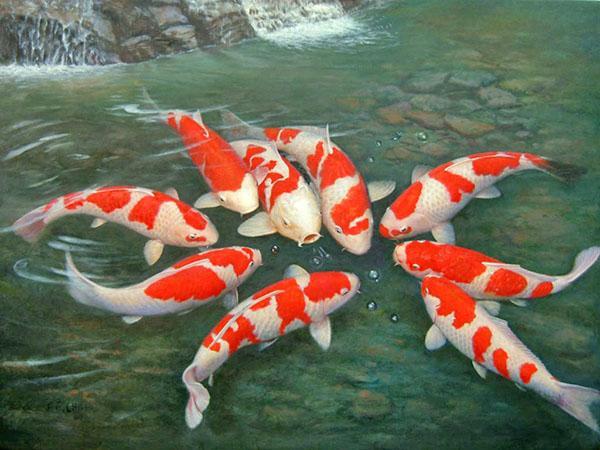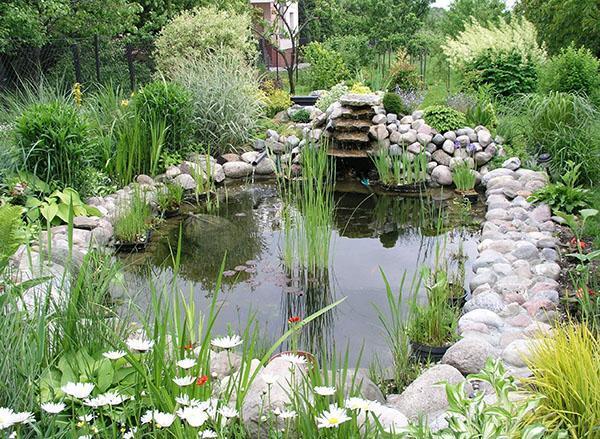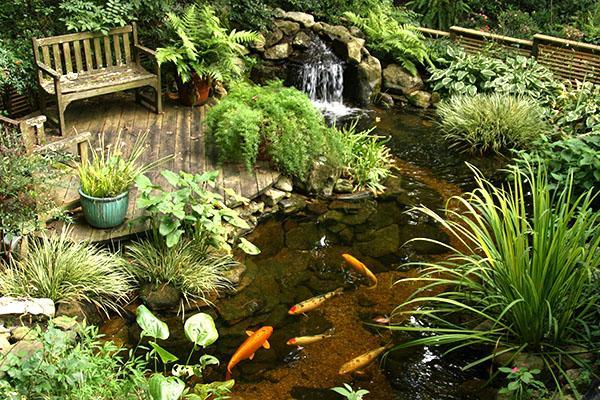How and why is liming of a fish pond carried out
 Liming the fish pond is an integral part of pond maintenance. Especially if the water remains in it for the winter.
Liming the fish pond is an integral part of pond maintenance. Especially if the water remains in it for the winter.
During the cold season, a large amount of waste products accumulates in it, such as:
- leftovers of feed;
- dead plants;
- zooplankton;
- organic matter;
- inhabitants excrement.
Liming of water is carried out to accelerate the mineralization of substances and add open oxygen. It also helps to improve fish production and water quality.
Read also the article:1 hectare - how many square meters?
What is it for

During the operation of the reservoir, lime is gradually washed out of the earth and water. It needs to be added periodically as it performs the following functions:
- Development of the inhabitants. Lime takes part in the formation of a skeleton in fish, affects the development of embryos and normalizes the functioning of the neuromuscular apparatus of the fish. During capture, a significant portion of the calcium is removed from the pond and needs to be added.
- Disinfection of water. Lime helps prevent gill disease and carp rubella.
- Fights most parasites living on the bottom and in the water. They simply cannot stand the effects of quicklime and die immediately after adding it.
- Helps to get rid of unnecessary (weed) fish. It is enough to process the remaining pits with water in autumn and spring, you can start the inhabitants.
How to activate the productive layer of the pond bed
 If the pond is equipped on poor sandy soils, liming the fish pond will be useless.
If the pond is equipped on poor sandy soils, liming the fish pond will be useless.
If there is a large amount of silt at the bottom of the reservoir, liming is mandatory.
 Here you need to use quicklime. It should be applied to the wet bottom soil. For liming to be successful, the substance must be in the form of small particles and it must be distributed evenly. Otherwise, blanking will not occur.
Here you need to use quicklime. It should be applied to the wet bottom soil. For liming to be successful, the substance must be in the form of small particles and it must be distributed evenly. Otherwise, blanking will not occur.
Quicklime is used only on a wet bottom. Do not apply it to dry or frozen ground.
The ice crust of the bottom can help in liming. If the pond is deep and there is enough silt in the bed, in spring the ice melts and the alkali is activated.
As soon as you have added lime, be sure to immediately process the soil, otherwise there will be no effect. This is due to the fact that quicklime reacts with oxygen and quickly becomes carbon dioxide, that is, it loses its properties.
It will not work to activate the sandy bed of the reservoir with quicklime. It interacts only with organic matter, and there are practically none of them in such soil. There will be no effect.
If the soil is in a pond with a high content of peat, quicklime will do an excellent job. It is possible to determine how much substance is needed in this case by two factors - the thickness of the silt layer in the bed and its current activity. The more silt, the more quicklime will be required. And the more active the bed, the less substance you need to add.
The recommended amount of adding quicklime to a peat bed is about 270 kg per 1 ha. In some cases, the amount reaches 2 tons per hectare.
Continuous dose increases are strongly discouraged.This can dramatically decrease the fish productivity of the pond.
Water enrichment rules
 The liming of the pond should be done with slaked and quicklime, as well as with crushed limestone.
The liming of the pond should be done with slaked and quicklime, as well as with crushed limestone.
Substances have different neutralizing ability: 1 kg of quicklime = 1.3 kg of slaked lime = 1.8 kg of limestone.
The action of limestone is slowed down in comparison with slaked and quicklime, since it dissolves worse. Therefore, the likelihood of overdose decreases.
With a fish productivity of 1 ton per 1 ha, liming of the pond with fish is necessary. When increasing up to 2.5 t / ha, it is mandatory.
Soluble lime (calcium bicarbonate) and calcium carbonate are used to increase the calcium content in the water. With an insufficient amount of the latter in water, calcium bicarbonate forms into a gray sediment at the bottom and underwater parts of plants. So there is a lack of lime.
Quicklime and calcium carbonate are used as fertilizers. This is how the quicklime dissolves and produces an alkaline solution. It, in turn, reacts with carbon dioxide and is converted to calcium carbonate.
For productive saturation of water with calcium, it is necessary that a sufficient amount of carbon dioxide is released in the reservoir. This condition can only be ensured by the sufficient presence of quicklime in the pond bed. It is practically the only source of carbon dioxide.
The pH value is also extremely important for the existence of bicarbonate carbon dioxide. When the pH level is above 8.5, the lime in the water becomes carbonic or alkaline.
The lime content in water is strongly influenced by plants living in pond... For example, some of them actively absorb carbon dioxide, while others absorb dissolved lime. Water with the latter acquires a pH of 9-10.
Liming is necessary. It allows you to neutralize all harmful compounds, including iron, magnesium, sodium, copper and potassium. Iron compounds are especially dangerous. They are easily recognized by their metallic luster and film formation on the surface of the water. It looks like an oily one, but when it breaks, it does not rejoin, but floats in pieces. Such areas of the film are dangerous for fish - they get into the gills and partially block breathing. Lime can solve this problem.
When liming a pond, it should be borne in mind that in autumn the lime content in the silt is higher than in spring, and in the new reservoir it is less than in the old one.
In some cases, activating liming is sufficient, while in others additional fertilization is required. Here you need to look at a specific reservoir.
How much lime is needed for a pond
 To determine the required amount, you need to consider the following factors:
To determine the required amount, you need to consider the following factors:
- dry bed or water;
- with fish or after catching;
- what bottom sediments are available;
- the presence and types of plants;
- initial water quality.
Liming a reservoir with a higher dosage is dangerous, since not only zooplankton and parasites, but also the fish itself, can die.
Increased doses of lime are applied only on a dry bed or on water without fish if the disease spreads among the inhabitants.
In almost all theoretical materials on this topic, there is a value of 280 kg of lime per hectare of pond with a depth of 1 meter. But, as practice shows, there are many more factors that must be taken into account:
- Plants in the pond absorb lime during development and release it after dying off.
- With natural evaporation of water, the lime in the residue becomes more concentrated.
- In the muddy bottom, the lime content is higher than in the sandy one.
 According to research, more ponds do not need lime storage because the lime content in pond silt reaches 1%.
According to research, more ponds do not need lime storage because the lime content in pond silt reaches 1%.
Silt has a higher density than water. If we conventionally take 7 cm of silt per hectare, we get 700,000,000 cubic cm. In this case, its weight will be 700,000 kg. That is, with a lime content of 1%, this amount of sludge accounts for about 7 tons. But since this content is not free, it cannot be taken into account.Sludge produces approximately 10% of the total lime content in it, that is, 0.1%. Thus, an alkalinity of 2.5 meq / l appears. This value is most suitable for pond farming.
Disinfection with lime
 To disinfect the pond on a dry bed, apply 0.5 kg per 10 sq. m, in wet areas - 1-1.2 kg per 10 sq. m. Liming of ponds by water is carried out twice a year - from May to June and before the introduction nitrogen-phosphorus fertilizers (in 2-3 days). Consumption here will be 100 g per 10 sq. m.
To disinfect the pond on a dry bed, apply 0.5 kg per 10 sq. m, in wet areas - 1-1.2 kg per 10 sq. m. Liming of ponds by water is carried out twice a year - from May to June and before the introduction nitrogen-phosphorus fertilizers (in 2-3 days). Consumption here will be 100 g per 10 sq. m.
The use of quicklime is effective here. Disinfection must be carried out at an ambient air temperature of 1 ° C.
For this purpose, only fresh quicklime is suitable. If it has been stored for a long time or the container has been opened, the substance has already lost its properties.
The rate in this case is higher than that used to activate the ponds. So, on a muddy bottom, 2 t / ha will be required, on a sandy bottom - 750 kg / ha, and on a peat bottom up to 4 t / ha.
 When applying, the main thing is to evenly distribute the substance along the bottom.
When applying, the main thing is to evenly distribute the substance along the bottom.
Coarse particles (not crushed enough) of quicklime can harm fish.
The fact is that they are extinguished only from the outside, while forming a crust that does not allow internal extinguishing of the granules. When launched, fish can touch and disturb this layer. As a result, the process of slaking the lime remaining inside will begin. This can harm the fish by generating heat and alkali.
Lime application methods
Most often, slaked lime is used for liming water in a pond. It is easier to store because it does not absorb moisture from the environment (as with quicklime).
Liming ponds by water can only be effective if there is a large amount of organic matter in the pond.
There are several methods for adding lime to a pond. Mechanized ones, of course, are more convenient and more efficient, but consider not only them:
- Manual application from the boat starts at the same time as feeding. Quicklime is used in the amount of 12% of the mass of fish in the pond. The dosage is gradually reduced so that by the end of the season it is equal to 6% of the fish weight.
- Application with a shovel into the ground. Only here you need not an ordinary garden shovel (it will create a lot of dust and you will not get an even distribution). There is a special device that looks like a spade with slots. It helps to distribute the lime evenly over the bottom. To avoid getting dust on your face, you need to watch out for the wind.
- It is possible to spray with milk of lime - lime previously slaked and dissolved in water. For this, only containers of their stainless materials are suitable.
- There is an interesting atomizer model. The boat is equipped with a suction and discharge pumps, a mixer and a flexible pipe. The latter is equipped with a movable transverse tube with nozzles. When the boat moves, the pump draws in water from the reservoir, lime is extinguished in the mixer and lime milk is sprayed. In this case, the recoil is quite enough for the movement of the boat. But even this method has its drawbacks - when the wind blows, the fertilizer will not reach its destination.
- Pendulum spray and box diffuser are recommended. They move along a dehydrated pond using a tractor or tractor.
Liming water bodies is a necessary measure to maintain a healthy pond ecosystem and improve fish productivity. Calculation of lime consumption for each pond must be made taking into account many factors. An overabundance is as bad as a lack of substance.
Good day. Is technical dispersive chalk suitable for liming a pond?
Hello! I have a very small pond, 2.5 x 3m. Depth 1m. The bottom is a film. Despite this, crucians have been living for the 5th year. Occasionally I catch it. The water is green (especially in spring). I use the pond for watering.Tell me, do you need to lime? If necessary, how much lime should be added and which is better (slaked or quicklime). Thank you in advance.